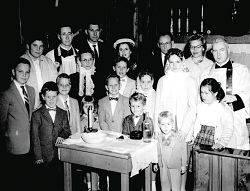Beauty and Truth in the Eucharist: Utah's Catholic Community Has Uneven History of Including People with Disabilities

Michael Courtney
Archivist, Diocese of Salt Lake City
“Ultimate perfection has to do with everything and everyone being drawn together in the life of God. Perfection is not found in a single model but in the assembly. There’s something ingenious about how people gather for the Eucharist. It is the place where the sacred is. The more different pieces you have there together in the assembly, the more sacred it is. That way no beauty or truth is excluded.” – Donald Senior, C.P. U.S. Catholic, March 1994, p.16
Donald Senior, C.P., president emeritus, chancellor and professor of the New Testament at the Catholic Theological Union, spoke these words during an interview on the topic of people with disabilities. Senior’s statement succinctly summarizes the view the Catholic Church has held toward people with disabilities and the Eucharist, in that the Catholic Church has long recognized the “more different pieces you have there together in the assembly, the more sacred it is.”
The Church has always tried to be inclusive. For example, the Catholic Church endorsed Deaf Catholics organizing the International Catholic Deaf Association in 1949. At the same time, Senior’s quote also suggests that without “different pieces” the less sacred an assembly is.
The Church has also been exclusive. Prejudices by able-bodied Catholics have prevented Catholics with disabilities from fully participating in the Mass. In a recent story on the synodal listening session for the people with disabilities held at the Vatican, the Arlington Catholic Herald reported that many Catholics still believe that individuals with disabilities do not and cannot understand the Church teachings and, therefore, should be excluded from receiving Communion.
Traces of the above tensions exist in Utah’s Catholic history. Early on in this history, Catholics with disabilities publicly shared the Eucharist. On Nov. 25, 1899, the Intermountain Catholic announced that “on the 17th of November Miss Thresa Rasche and Mr. Paul Mark were married by Father Kiely,” at the Cathedral of the Madeleine, noting that both Rasche and Mark were Deaf and the Mass was celebrated in sign language.
The fact that Mark and Rasche had their nuptial Mass celebrated in sign language meant that the couple had learned catechism in sign language, thus allowing them to receive the sacraments. It also meant that there was a Deaf Catholic community in Utah that participated in the sacramental life of the Church, because either someone learned to interpret the Mass in sign language or Fr. Kiely learned sign language to serve the Deaf.
By the 1960s, Utah’s Catholic Deaf community continued to make progress by organizing a local chapter of the Catholic International Deaf Association. This chapter started a monthly Mass for the Deaf community and organized Confraternity of the Christian Doctrine programs for Deaf students at St. Joseph Parish in Ogden.
For the blind, Catholic publishing houses printed books in extra-large print or books in braille. When blindness took the eyesight of the Most Reverend Duane G. Hunt, fifth Bishop of Salt Lake, he purchased extra-large print missals in order to continue to celebrate Mass – without these, Bishop Hunt would have had to memorize the Mass.
During the 1970s, some parishes established CCD classes for children with special needs. In 1975, at St. Marguerite Parish in Tooele, Sr. Loretta Marie Marbach, S.H.F started a parish level special education program. Sr. Loretta Marie told the Intermountain Catholic that the program was primarily concerned “with helping these young people grow in a loving relationship with the Lord and preparing them for First Communion and Confirmation.”
Through the efforts of individuals who were Deaf, blind and living with other disabilities, the Catholic Church in Utah made many strides during the 20th century to make the Eucharist accessible to them. However, by the end of the century, many obstacles still existed for Catholics with disabilities to fully join in the Eucharistic banquet. One reason for this is, as Bibian J. Rendon, then coordinator for the diocesan Office of Persons with Disabilities, explained in a 1992 interview, many Catholics do not want others to know about their disability: “For many, many years, our society has looked down upon people with disabilities.”
He continued, saying that a person with hearing difficulties would “rather put up with the tortures of not hearing or misinterpreting” than let someone in Church know that they are having trouble hearing Mass.
Other hurdles for full participation in the Mass include the lack of accessible entrances for those with mobility issues, the paucity of transportation for those who either cannot walk or drive, and the absence of trained liturgical ministers with disabilities in parishes.
The invisibility of disabilities within the Catholic community remains one of the greatest issues for the Catholic Church in Utah. The more the Church obscures members, the less sacred the assembly. By living their lives publicly, Catholics with disabilities make the Church assemblies more sacred: Paul Mark and Thresa Rasche visibly marked their wedding using sign language. Bishop Hunt continued his ministry despite losing his eyesight. Students with learning disabilities studied their catechism. At the end – “no beauty or truth is excluded.”
© Copyright 2024 The Diocese of Salt Lake City. All rights reserved.

Stay Connected With Us